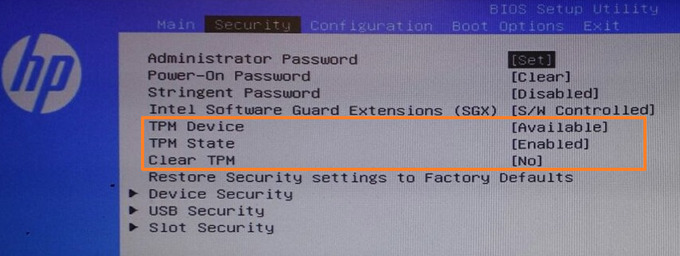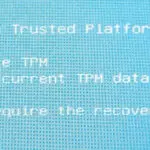If after performing a BIOS update on a HP laptop, you receive the message “There is an issue with Trusted Platform module (TPM) data”, continue below to fix the problem.
HP laptop owners may receive the following error after performing a successful BIOS/Firmware update:
There is an issue with Trusted Platform Module (TPM) data.
Press [Y] – Reset whole TPM
Press [N] – Boot with current TPM dataNote: BitLocker may require the recovery key to boot to Windows.


The error message “There is a problem with the Trusted Platform Module (TPM) data” usually indicates a problem with the TPM, a hardware-based security feature on modern computers that is used in conjunction with BitLocker to encrypt the data on the computer’s hard drive.
How to FIX: There is an issue with Trusted Platform module (TPM) data on Windows 10/11.
To solve the error “There is a problem with the Trusted Platform Module (TPM) data” startup error on HP Laptops, follow the steps below:
Step 1. Disable Device Encryption or BitLocker.
Since the TPM module stores the security keys used by the BitLocker encryption (aka “device encryption”), before proceeding further, go ahead and disable the encryption (if it is enabled) on your system, otherwise you will lose your data.
1. On the message “There is an issue with Trusted Platform Module (TPM) data” press the “N” key to boot with current TPM Data.


2. After booting into Windows, check if device encryption (BitLocker) is enabled on your computer and if it is enabled, disable it, by following the steps below according to your Windows version:
Windows 10/11 Home.
a. On Windows 10/11 Home version, type “device encryption settings” on search and then open the Device encryption settings. *
* Note: If you couldn’t find the ‘device encryption settings’ then your system doesn’t support encryption, or you’re running Windows 10/11 Pro. At such case, check if BitLocker is enabled and if not, skip to Step-2.


b. Now according the Device Encryption status, do the following:
- If the Device Encryption is OFF skip to Step-2.
- If the Device encryption is ON, set the related switch it to OFF to disable the encryption on your system. Then click Turn off when asked to remove the device encryption, and wait until your data is decrypted. When this done, proceed to Step-2.


Windows 10/11 Pro & Enterprise.
a. On Windows 10/11 Pro and Enterprise versions, type “manage bitlocker” and then click Manage BitLocker.


b. At ‘BitLocker Drive Encryption’ screen, check if the BitLocker is On* on the operating system drive, and if so, click Turn off BitLocker and then wait for BitLocker to decrypt and unlock the drive. When this done, proceed to Step-2
* Note: If BitLocker is OFF proceed to Step-2


Step 2. Back up your data (Precautionary step).
Important: As a precaution and before proceeding to the next step, I recommend that you take a backup copy of your important personal files* to an external USB drive.
* Usually, all your important files are stored on the following folders under the “C:Users<YOURUSERNAME>” folder:
- Desktop, Documents, Downloads, Music, Pictures, Videos.
So, as precaution, copy these folders to a USB drive among with any other folders or files you may need, before clearing the TPM keys.
Step 3. Clear TPM in Windows 10/11.
After disabling the encryption on your system and backing up your data, go ahead and reset the TPM to its default settings, as instructed below:
1. Type windows security in the search and then open the Windows Security app.


2. In Windows Security, select Device security on left and click Security processor details on right.*
* Note: If on this screen you see the message “There is no TPM available. Please check you BIOS settings“, skip to Step-4 below.


3. Then click Security processor troubleshooting.


4. Under Clear TPM section, click Select and then click I am trying to fix issues after a firmware update occurred.


5. Then click Clear TPM to reset the TPM to its default settings.


6. Now read carefully the information message and then click Clear and restart. *
* Important: If you sign-in to Windows using a PIN then you’ll be asked to change your PIN at next logon. To do that, you must know your account’s password. If you haven’t set a password, proceed and specify one before clearing the TPM (in Settings > Accounts > Sign-in options).


7. During the restart, you might be prompted by the UEFI to press a button to confirm that you wish to clear the TPM. If so, press the corresponding key.
8. After restart, you should be able to log in to Windows normally. At this point you’re done! Just shutdown and restart your computer to ensure that the “There is an issue with Trusted Platform Module (TPM) data” error is gone and you’re ready to go! *
* Notes:
1. If everything is OK you can proceed to re-enable the device encryption in Windows if you want to use it (see Step-1 above).
2. If after following the above steps you still receive the error “There is an issue with TPM data”, proceed to next step.
Step 4. Enable and Reset TPM in BIOS Settings.
If you cannot clear (reset) the TPM module from within Windows, proceed and reset it in BIOS settings as instructed below: *
* Important: If you sign-in to Windows using a PIN then you’ll be asked, after resetting TPM, to change your PIN at next logon. To do that, you must know your account’s password. If you haven’t set a password, proceed and specify one before clearing the TPM (in Settings > Accounts > Sign-in options).
1. Shutdown your laptop.
2. Power On you laptop again and when you see the HP logo press the F10 key to enter in BIOS Setup Utility.
3. In BIOS setup, go to Security settings page.
4. Now, check if the TPM Device is Available and if the TPM State is Enabled. Then, according your case, do one of the following:
- If the TPM Device is Available and the TPM State is Enabled, select the Clear TPM option below and press Enter and then Yes to reset the TPM to its default settings, or select and press Enter at the option Restore Security settings to Factory Defaults.
- If the TPM Device is Available but the TPM State is Disabled, select the TPM State option and press Enter to Enable it.


- If you don’t see the TPM settings in BIOS or you see that the TPM Device is “Not Available“, do the following:
- Shutdown the laptop and disconnect the AC adapter and the battery (If it is removable).
- Now press and hold down the Power button for over 60 seconds to discharge the static power.
- Then Power On your laptop again and enter in BIOS setup to find out if the TPM is available. If so, follow the instructions above to reset the TPM from BIOS setup.
5. After making the above changes in BIOS, press F10 to save changes and exit from BIOS setup.
6. After the laptop restarts, you may be asked to accept the change by pressing a corresponding on your keyboard. If so, press that key (usually is the “F1“ key), to reset the TPM and clear all its security keys.
7. Finally, let your computer to boot to Windows and you’re done!
* Note: If everything is OK you can proceed to re-enable the device encryption in Windows if you want to use it (see Step-1 above).
Additional troubleshooting steps.
If after following the above steps, you still face the error “There is an issue with the Trusted Platform module (TPM) data“, try the following:
- Enter in BIOS setup and Disable the TPM State. Then Save and Exit from BIOS settings. Then, without booting to Windows, re-open BIOS settings and re-Enable the TPM State. Save and exit again and let your system to boot to Windows. If everything is OK, you’re done here!
- Press “Y” on the message “There is an issue with the Trusted Platform module (TPM) data” to reset TPM and then try to boot to Windows. If everything is OK, you’re done here!
- Visit the HP Support website to download and install the latest TPM drivers and firmware updates from your laptop model.
- Contact the HP customer support and ask them if there is a solution to the problem.
That’s all folks! Did it work for you?
Please leave a comment in the comment section below or even better: like and share this blog post in the social networks to help spread the word about this solution.



